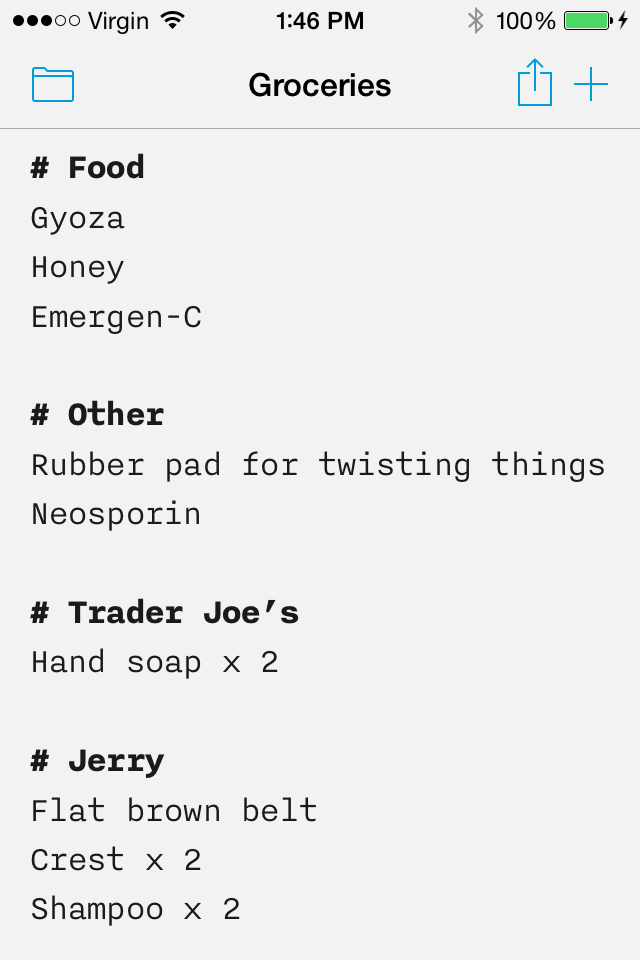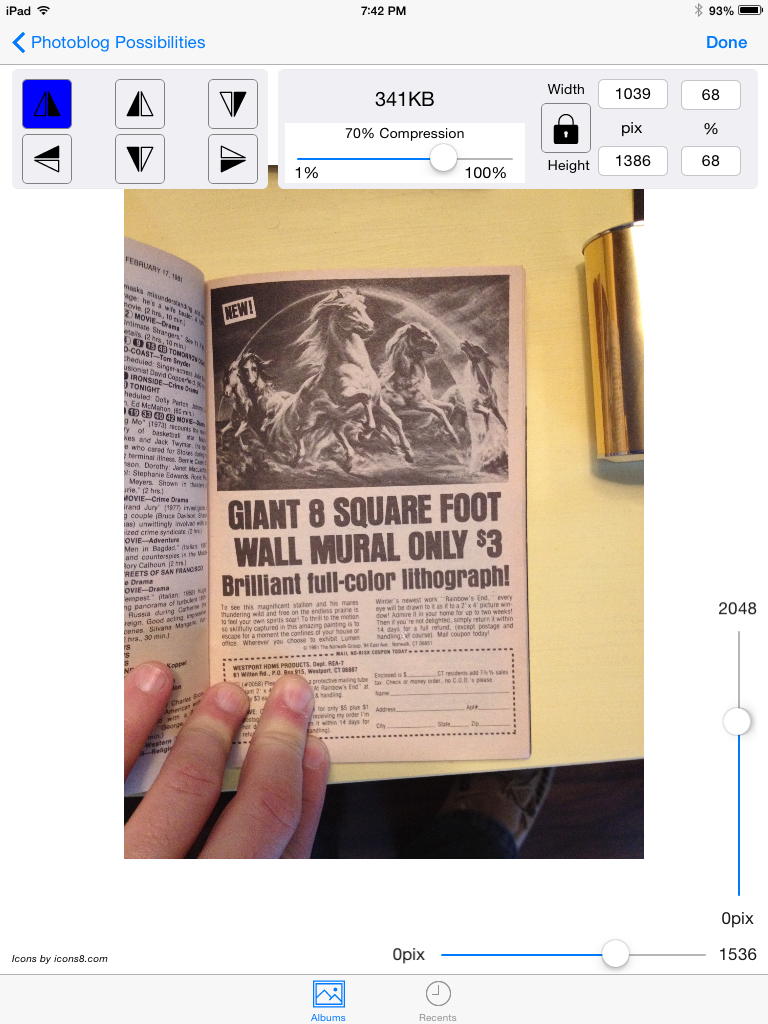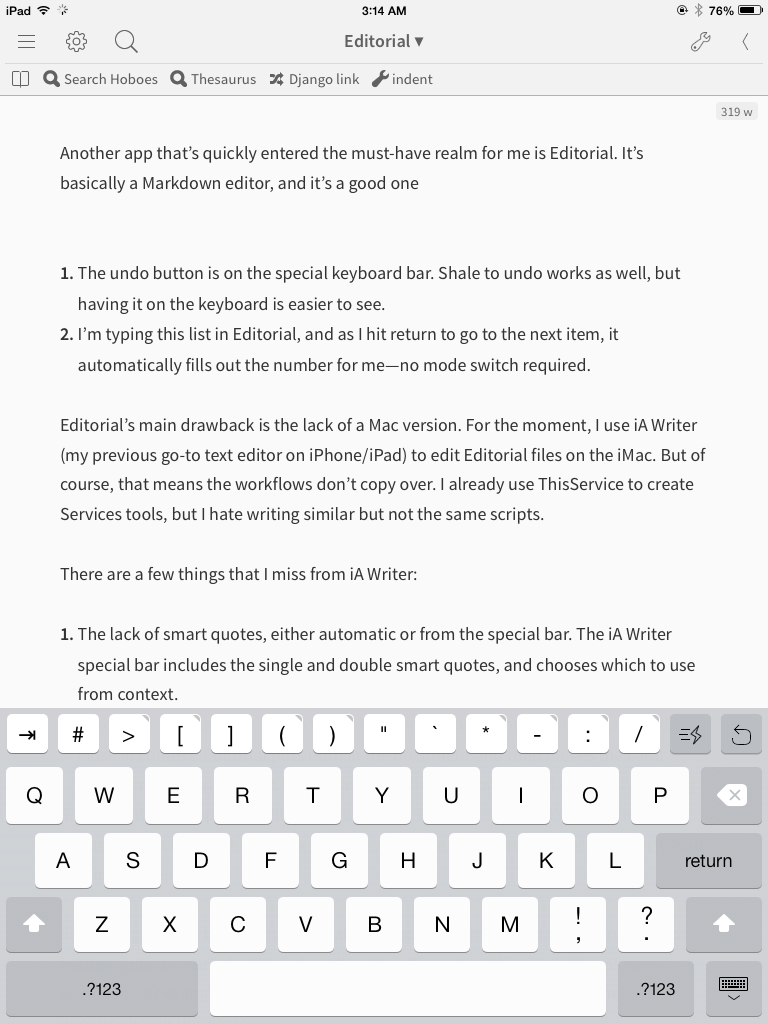Must-have iOS apps
- August 11, 2015: Photo Resize, Rotate, Flip & Compress
-
I have long been looking for a good iPad app that can easily compress and resize images for my blogs. Until now, I’ve had to search out the secondary features of image-editing apps, and even then the process seemed less than secondary and more just a side-effect.
And then on my last trip, I found out the app I’d been using no longer even worked on my iPad, and had been pulled from the app store.
Fortunately, I was able to find Photo Resize, Rotate, Flip & Compress by Rowel Atienza. It’s not free, but it is only 99 cents, and it provides a simple interface for changing the dimensions of an image and choosing the compression ratio. You can use sliders to adjust compression and dimensions, and you can enter exact dimensions in the boxes provided.
While adjusting dimensions and compression, it also recalculates the resultant file size and displays it.
Photo Resize saves only as JPEG, which is appropriate since its main purpose is choosing an appropriate JPEG compression ratio.
As the app’s title indicates, it also allows flipping images vertically or horizontally, and rotating them in ninety-degree increments; however, I don’t personally have a use for those features, so I haven’t tested them.
Photo Resize would be perfect if it also handled cropping images, but the built-in Photos app on iOS handles cropping already, so the lack of it isn’t much of a flaw. A more glaring omission is the lack of visual feedback when reducing the compression ratio. The app only shows the compression’s degradation after hitting Done to send the image off to another app. Mind you, if you don’t like the results a quick tap on Back allows you to readjust the settings. And in its defense, the image quality after even high compression is extremely good.
This app is a must have for bloggers and anyone needing to resize images on the fly. I’m still amazed at how many photo apps do not let you resize or compress the images you edit, and that give no feedback on how big—in file size and thus download time—your image is. And some that do, don’t even show what dimensions you’re resizing to. Photo Resize does both, in a simple interface.
- October 13, 2014: ia Writer for iOS and Mac OS
-

Because ia Writer is available on Mac and iOS, and uses iCloud to sync, it is great for simple lists such as shopping lists.
Most of my non-fiction writing nowadays is in ia Writer.1 I first picked up ia Writer on the iPad because I needed a good program for writing blog posts on the fly. Because the same app worked on both the iPad and the iPhone, I ended up using it for simple lists, such as my grocery list. It uses iCloud to seamlessly synchronize between the two devices, as long as I come near a WiFi network on the iPad. Which, increasingly, is not a problem.
When I saw that there was a Mac OS version of ia Writer, I immediately picked that up, too; it means that I can switch immediately from iPad to iMac for serious writing, and for quick changes use the iPhone on the run. I use ia Writer on Mac OS probably more than any other app; I’m writing this review in it, for example.
When I’m done, ia Writer on iOS can export to HTML, PDF, and “formatted text” for pasting into other apps. Of course, as a Markdown app the text can be copied exactly into Editorial or any other Markdown app. And of course ia Writer on Mac OS can export to PDF just like any other app; and it can copy to HTML, which I will use to paste this into my blog software.
Combined with ThisService, ia Writer on the Mac is a great part of my writing workflow.
What keeps me using ia Writer, besides its presence on all three of my devices, is that it is designed around writing. This is especially obvious when using the iPad’s built-in keyboard. It features a bar on the top that contains automatic smart quotes and automatic parentheses. It also puts the dash, asterisk, and pound front-and-center for use in Markdown, characters normally hidden behind going to numbers and then going from numbers to special characters on the default iOS keyboard.
- July 10, 2014: Must-have iOS app: Editorial
-
Another app that’s quickly entered the must-have realm for me is Editorial. It’s basically a Markdown editor, and it’s a good one. It is a universal app, working on both the iPad, for which it was designed, and the iPhone.
- The undo button is on the special keyboard bar on the iPad. Shake to undo works as well, but having it on the keyboard is easier to see.
- I’m typing this list in Editorial, and as I hit return to go to the next item, it automatically fills out the number for me—no mode switch required.
- It seems simple, but it apparently isn’t—iA Writer only received this functionality as I was writing this review—Editorial displays Markdown files with formatting. A quote is indented, emphasized text is emphasized, and so on.
One interesting feature—and one that’s very useful to TaskPaper users—is that it recognizes .taskpaper files and displays them as tasks with checkboxes that can be checked off. I store my task lists on Dropbox, and can then edit them both on my iMac (using TaskPaper) and on my iPad/iPhone (using Editorial). Only the iPad can currently easily check off tasks; however, the special bar of the onscreen keyboard changes to be appropriate for TaskPaper files, on both the iPad and the iPhone.
Using Editorial just as a Markdown editor, note editor, and TaskPaper editor on the iPhone and iPad is enough right there. The killer, though, is the workflow feature. Within the workflow editor are simple tasks that can be chained together to form a workflow; for example, I often look on Wikimedia Commons for related imagery; I can now select the text I’ll be searching for and hit a button in Editorial to search. The web page is brought up within Editorial making moving back and forth faster.
I have another workflow for blockquoting selected text. People use workflows for uploading posts to their blogs, tweeting selected text, and titleizing selected text.
Workflows can be organized by tagging them, and then filtering by tags, by tapping a button with that tag’s name.
Finally, workflows can include custom Python code, putting pretty much no limit on what you can do to your text in a workflow.
- June 21, 2014: Must-have iPad app: Inkpad
-
While on a recent road trip, I had the occasion to want to add text to a photo. There are lots of apps to do this on the App Store, but I had happened to download Inkpad just before leaving, and took a look at it.
My example is not nearly as interesting as the examples on the Inkpad review page, but I thought it pretty cool. After drawing a path, you can add text to it. Then, I added a seventies gradient: yellow to orange. The point in my case was to make a cheesy postcard (using Bill Atkinson’s PhotoCard, but Inkpad is capable of a lot more than that. It’s a full SVG app with layers. You can create drawings from scratch, or import photos and draw over them. When you’re done, you can export to the usual places (Facebook, Twitter, Photo album) as well as to PNG, PDF, or SVG.
You can see the toolbar in the photo; it has most of the standard tools: pen, brush, eraser, straight lines (which includes polygons), and so on. It can also align and distribute objects, undo and redo, choose from a multitude of fonts, adjust shadow and opacity, edit stroke and fill, and snap to points, edges, and grids.
It’s an impressive tool to keep available on the road. The iPad has come a long way; our road trip was six weeks long and I only missed having a laptop once, and that was unrelated to real work.1 Blogging, writer, programming, recording, image editing and creation, desktop publishing, there’s an app for it and the app works great!
Besides Inkpad, their Brushes is also interesting, but I haven’t had a chance to play with it much yet.
More iOS apps
- Photo Resize, Rotate, Flip & Compress
- This is a simple app that fills a surprising gap in Photo apps: it allows resizing and compressing images with automatic recalculation of file size.
- HotPaw Basic on iOS
- Looks like there’s a minor renaissance in programming languages on the iPhone and iPad. HotPaw BASIC is one of the first.
- Must-have iOS app: Editorial
- Editorial stands out among Markdown editors by being far more flexible and at the same time easier to use.
- Must-have iPad app: Inkpad
- The Inkpad app makes it easy to not only create vector (SVG) graphics on the iPad, but also to add them to existing photographs.
- Apple goes to the Swift
- The most exciting part of the WWDC keynote last Monday wasn‘t the new operating systems for the Macintosh and iDevices. It was the announcement of the new Swift programming language for MacOS and iOS. A new programming language is my equivalent of “one more thing…”



